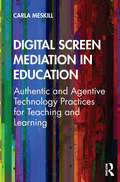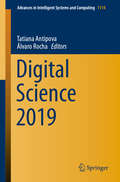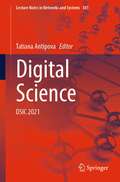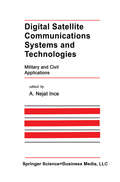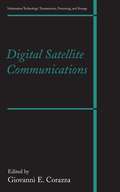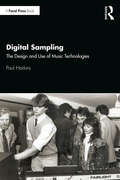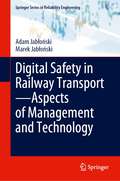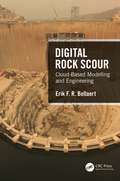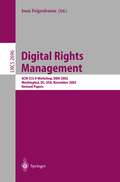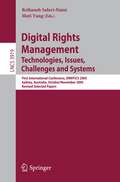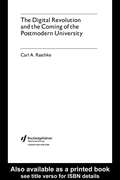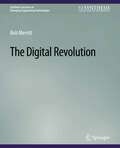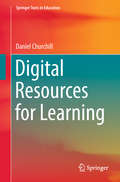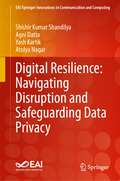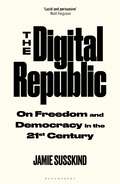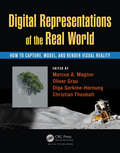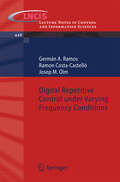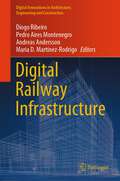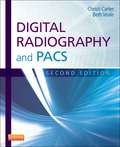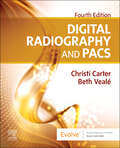- Table View
- List View
Digital Screen Mediation in Education: Authentic and Agentive Technology Practices for Teaching and Learning
by Carla MeskillDigital Screen Mediation in Education explores the complex role of visual mediation in today’s digitally enhanced classrooms. While the notion that technology tools have agency—that they act to induce learning—pervades contemporary conversations about pedagogy, this unique volume reframes instructional agency around teachers. The book’s theoretically reinforced and multidisciplinary approach to enhancing effective instruction with screen-based technologies spans aesthetics, technical knowledge, teacher empowerment, social media, and beyond. Researchers in educational technology, instructional design, online learning, and digital pedagogies as well as prospective and practicing educators will find a rigorous treatment of how skilled, thoughtful teaching with, through, and around digital screens can bring about successful learning outcomes.
Digital Screen Mediation in Education: Authentic and Agentive Technology Practices for Teaching and Learning
by Carla MeskillDigital Screen Mediation in Education explores the complex role of visual mediation in today’s digitally enhanced classrooms. While the notion that technology tools have agency—that they act to induce learning—pervades contemporary conversations about pedagogy, this unique volume reframes instructional agency around teachers. The book’s theoretically reinforced and multidisciplinary approach to enhancing effective instruction with screen-based technologies spans aesthetics, technical knowledge, teacher empowerment, social media, and beyond. Researchers in educational technology, instructional design, online learning, and digital pedagogies as well as prospective and practicing educators will find a rigorous treatment of how skilled, thoughtful teaching with, through, and around digital screens can bring about successful learning outcomes.
Digital Science 2019: Icis 2019 (Advances in Intelligent Systems and Computing #1114)
by Tatiana Antipova Álvaro RochaThis book presents the proceedings of the 2019 International Conference on Digital Science (DSIC 2019), held in Limassol, Cyprus, on October 11–13, 2019. DSIC 2019 was an international forum for researchers and practitioners to present and discuss the most recent innovations, trends, results, experiences and concerns in digital science. The main goal of the conference was to efficiently disseminate original findings in the natural and social sciences, art & the humanities. The contributions in the book address the following topics: Digital Art & Humanities Digital Economics Digital Education Digital Engineering Digital Finance, Business & Banking Digital Healthcare, Hospitals & Rehabilitation Digital Media Digital Medicine, Pharma & Public Health Digital Public Administration Digital Technology & Applied Sciences Digital Virtual Reality
Digital Science: DSIC 2021 (Lecture Notes in Networks and Systems #381)
by Tatiana AntipovaThis book gathers selected papers that were submitted to the 2021 International Conference on Digital Science (DSIC 2021) that aims to make available the discussion and the publication of papers on all aspects of single and multidisciplinary research on conference topics. DSIC 2021 was held on October 15–17, 2021. An important characteristic feature of conference is the short publication time and worldwide distribution. Written by respected researchers, the book covers a range of innovative topics related to: digital economics; digital education; digital engineering; digital environmental sciences; digital finance, business and banking; digital health care, hospitals and rehabilitation; digital media; digital medicine, pharma and public health; digital public administration; digital technology and applied sciences. This book may be used for private and professional non-commercial research and classroom use (e.g., sharing the contribution by mail or in hard copy form with research colleagues for their professional non-commercial research and classroom use); for use in presentations or handouts for any level students, researchers, etc.; for the further development of authors’ scientific career (e.g., by citing, and attaching contributions to job or grant application).
Digital Satellite Communications Systems and Technologies: Military and Civil Applications (The Springer International Series in Engineering and Computer Science #186)
by A. Nejat InceAmong the space activities of the last three decades satellite communications (SATCOM) has found the widest application in meeting both civil and military communications requirements. Several international, regional and national SATCOM systems of increasing capacity, capability and complexity have been and are being implemented over the years. The latest versions are utilizing such concepts as spot beams, processing transponders in SS-TDMA and operations in different frequency bands including the EHF band. On the military side, the United States of America, the United Kingdom, France and NATO (the North Atlantic Treaty Organisation) have been the only owners and operators of military SATCOM systems in the West. The systems in being and under development use satellites and ground terminals with characteristics which differ from the civilian ones with respect to frequency bands utilised and survivability and interoperability. The SATCOM has given the military users the potential of having much-needed mobility, flexibility and survivability in strategic and tactical communications for land, sea and air operations. It must, however, be said particularly for the military SATCOM systems that they have been evolved in big jumps, both in time and capability, each jump involving the deployment of two or three often specially designed large satellites, large expenses and rather traumatic transition between jumps. Despite these undesirable features these systems did not have the required degree of suevivability and flexibility.
Digital Satellite Communications (Information Technology: Transmission, Processing and Storage)
by Giovanni E. CorazzaDiscusses long-term developments Addresses advanced physical layer techniques designed for broadband communications, for fixed and mobile terminals Considers 4G evolutions and possible convergence between different technologies
Digital Sampling: The Design and Use of Music Technologies
by Paul HarkinsDigital Sampling is the first book about the design and use of sampling technologies that have shaped the sounds of popular music since the 1980s. Written in two parts, Digital Sampling begins with an exploration of the Fairlight CMI and how artists like Kate Bush and Peter Gabriel used it to sample the sounds of everyday life. It also focuses on E-mu Systems and the use of its keyboards and drum machines in hip-hop. The second part follows users across a range of musical worlds, including US/UK garage, indie folk music, and electronic music made from the sounds of sewers, war zones, and crematoriums. Using material from interviews and concepts from the field of Science and Technology Studies (STS), Digital Sampling provides a new and alternative approach to the study of sampling and is crucial reading for undergraduates, postgraduates, and researchers from a wide range of disciplines, including music technology, media, communication, and cultural studies.
Digital Sampling: The Design and Use of Music Technologies
by Paul HarkinsDigital Sampling is the first book about the design and use of sampling technologies that have shaped the sounds of popular music since the 1980s. Written in two parts, Digital Sampling begins with an exploration of the Fairlight CMI and how artists like Kate Bush and Peter Gabriel used it to sample the sounds of everyday life. It also focuses on E-mu Systems and the use of its keyboards and drum machines in hip-hop. The second part follows users across a range of musical worlds, including US/UK garage, indie folk music, and electronic music made from the sounds of sewers, war zones, and crematoriums. Using material from interviews and concepts from the field of Science and Technology Studies (STS), Digital Sampling provides a new and alternative approach to the study of sampling and is crucial reading for undergraduates, postgraduates, and researchers from a wide range of disciplines, including music technology, media, communication, and cultural studies.
Digital Safety in Railway Transport—Aspects of Management and Technology (Springer Series in Reliability Engineering)
by Adam Jabłoński Marek JabłońskiThis book introduces modern safety management in rail transport, focusing on the challenges resulting from the digital economy. It details how the cybersecurity of railway technical systems and risk can be managed. The rail transport sector is increased integrated into the digital economy. Ensuing the safety of technical systems and managing the rail system as a whole are key challenges for rail transport designers, managers, users and other stakeholders. Developing of rail transport based on the interoperability of different systems requires both searching for modern solutions and ensuring a high level of standardization of processes. In the context of the widespread digitalization of railway systems, new hazards arise that can lead to undesirable events. This book examines these issues. The book will be of interest to rail professionals, and researchers into transport systems and reliability.
Digital Rock Scour: Cloud-Based Modelling and Engineering
by Erik BollaertThis book examines the digitalization of rock scour engineering at dams and hydraulic structures. It outlines the current digitalization (technologies, applications, issues) in rock engineering, as well as the digital evolution that has strongly characterized the development of computational methods in state-of-the-art rock scour over recent years. The challenges of rock scour digitalization are also discussed, such as parametric standardization, real-time data acquisition, data analysis and interpretation, quantitative rock mass indices, new ways of thinking and digital twin implementation. Further, it presents the major components and characteristics that are needed to develop an environment that implements rock scour digitally into dam safety procedures and dam risk analyses, such as IT platforms, database availability, topology, physics, computational methods, phase coupling, accessibility, portability, reliability, real-time and ahead-of-time implementations and more.Features: Provides an overview of physics-based computational methods that have been developed by the engineering community over the last 20 years, which can easily be implemented digitally into cloud-based platforms. Offers examples of the next-generation computational environment, combining both real-time computational power and an up-to-date scour database allowing new parametric refinements. Includes several case studies of real-life rock scour. Presents the latest Digital Twin developments, which are novel and new to dam operations.
Digital Rock Scour: Cloud-Based Modelling and Engineering
by Erik BollaertThis book examines the digitalization of rock scour engineering at dams and hydraulic structures. It outlines the current digitalization (technologies, applications, issues) in rock engineering, as well as the digital evolution that has strongly characterized the development of computational methods in state-of-the-art rock scour over recent years. The challenges of rock scour digitalization are also discussed, such as parametric standardization, real-time data acquisition, data analysis and interpretation, quantitative rock mass indices, new ways of thinking and digital twin implementation. Further, it presents the major components and characteristics that are needed to develop an environment that implements rock scour digitally into dam safety procedures and dam risk analyses, such as IT platforms, database availability, topology, physics, computational methods, phase coupling, accessibility, portability, reliability, real-time and ahead-of-time implementations and more.Features: Provides an overview of physics-based computational methods that have been developed by the engineering community over the last 20 years, which can easily be implemented digitally into cloud-based platforms. Offers examples of the next-generation computational environment, combining both real-time computational power and an up-to-date scour database allowing new parametric refinements. Includes several case studies of real-life rock scour. Presents the latest Digital Twin developments, which are novel and new to dam operations.
Digital Rights Management: ACM CCS-9 Workshop, DRM 2002, Washington, DC, USA, November 18, 2002, Revised Papers (Lecture Notes in Computer Science #2696)
by Joan FeigenbaumThe thoroughly refereed post-proceedings of the Second International Workshop on Digital Rights Management, DRM 2002, held in Washington, DC, USA, in November 2002, in conjunction with ACM CCS-9. The 13 revised full papers presented were carefully reviewed and selected for inclusion in the book. Among the topics addressed are DES implementation for DRM applications, cryptographic attacks, industrial challenges, public key broadcast encryption, fingerprinting, copy-prevention techniques, copyright limitations, content protection, watermarking systems, and theft-protected proprietary certificates.
Digital Rights Management: Technologies, Issues, Challenges and Systems (Lecture Notes in Computer Science #3919)
by Reihaneh Safavi-Naini Moti YungThis book constitutes the thoroughly refereed post-proceedings of the First International Conference on Digital Rights Management: Technology, Issues, Challenges and Systems, DRMTICS 2005, held in Sydney, Australia, in October/November 2005. Presents 26 carefully reviewed full papers organized in topical sections on assurance and authentication issues, legal and related issues, expressing rights and management, watermarking, software issues, fingerprinting and image authentication, supporting cryptographic technology, P2P issues, implementations and architectures.
The Digital Revolution and the Coming of the Postmodern University
by Carl A. RaschkeIn recent years, the powerful social, cultural and economic changes wrought by digital technology have led many to forecast the end of the university as we know it. This book employs extensive research and case studies to explain why these predictions, even if perhaps somewhat premature, are on solid ground.The Digital Revolution and the Coming of the Postmodern University shows how the internet, high-speed electronic communications and personal computers necessitate a radical rethinking of what is meant by 'higher education'. The book calls into question both the traditionalist's scepticism about the benefits of new technology, and the corporate e-learning advocate's failure to grasp that education is more than what happens on a computer screen. The author provides concrete data and models for more democratic, restructured systems of instruction that not only take advantage of advanced learning technologies, but promote the globalisation of higher education.This is an essential read for anyone concerned about the future of higher education.
The Digital Revolution and the Coming of the Postmodern University
by Carl A. RaschkeIn recent years, the powerful social, cultural and economic changes wrought by digital technology have led many to forecast the end of the university as we know it. This book employs extensive research and case studies to explain why these predictions, even if perhaps somewhat premature, are on solid ground.The Digital Revolution and the Coming of the Postmodern University shows how the internet, high-speed electronic communications and personal computers necessitate a radical rethinking of what is meant by 'higher education'. The book calls into question both the traditionalist's scepticism about the benefits of new technology, and the corporate e-learning advocate's failure to grasp that education is more than what happens on a computer screen. The author provides concrete data and models for more democratic, restructured systems of instruction that not only take advantage of advanced learning technologies, but promote the globalisation of higher education.This is an essential read for anyone concerned about the future of higher education.
The Digital Revolution (Synthesis Lectures on Emerging Engineering Technologies)
by Bob MerrittAs technologists, we are constantly exploring and pushing the limits of our own disciplines, and we accept the notion that the efficiencies of new technologies are advancing at a very rapid rate. However, we rarely have time to contemplate the broader impact of these technologies as they impact and amplify adjacent technology disciplines. This book therefore focuses on the potential impact of those technologies, but it is not intended as a technical manuscript. In this book, we consider our progress and current position %toward on arbitrary popular concepts of future scenarios rather than the typical measurements of cycles per second or milliwatts. We compare our current human cultural situation to other past historic events as we anticipate the future social impact of rapidly accelerating technologies. We also rely on measurements based on specific events highlighting the breadth of the impact of accelerating semiconductor technologies rather than the specific rate of advance of any particular semiconductor technology. These measurements certainly lack the mathematic precision and repeatability to which technologists are accustomed, but the material that we are dealing with—the social objectives and future political structures of humanity—does not permit a high degree of mathematic accuracy. Our conclusion draws from the concept of Singularity. It seems certain that at the rate at which our technologies are advancing, we will exceed the ability of our post‒Industrial Revolution structures to absorb these new challenges, and we cannot accurately anticipate what those future social structures will resemble.
Digital Resources for Learning (Springer Texts in Education)
by Daniel ChurchillThis book addresses the theory and practice of using digital resources for contemporary learning, and how such resources can be designed, developed, and employed in a variety of learning activities and with various devices. Drawing on insights into learning theory, educational research and the practical design of digital resources for learning that the author has gained over the past 20 years, the book provides the first classification guide to digital resources for learning and links various types of digital resources for learning to both contemporary curriculum design and learning design models.
Digital Resilience: Navigating Disruption and Safeguarding Data Privacy (EAI/Springer Innovations in Communication and Computing)
by Shishir Kumar Shandilya Agni Datta Yash Kartik Atulya NagarThis book offers an in-depth overview of digital resilience, defined as the ability of individuals, organizations, and societies to adapt to and counter various digital threats such as cyberattacks, data breaches, and other forms of cyber threats. Digital resilience not only enables proactive measures but also ensures fault-tolerant planning and design. The book elaborates on the necessary techniques and methods to achieve digital resilience. Key methodologies, including quantum computing, post-quantum cryptography, nature-inspired cybersecurity, zero-trust systems, zero-knowledge proofs, multi-party computation, and the emerging field of space security, are discussed in detail. The book provides insights into artificial intelligence and machine learning, examining their impact on society and organizations. It critically analyses the role of cybersecurity in businesses, emphasizing its importance for safety and economic stability. In addition, the book discusses notable cyber incidents, offering valuable insights into digital resilience. It serves as a comprehensive compilation, featuring key terms, definitions, case studies, and references to existing literature and research in cybersecurity, analytics, information sciences, future computing, digital resilience, and related fields.
The Digital Republic: On Freedom and Democracy in the 21st Century
by Jamie SusskindA FINANCIAL TIMES BOOK TO READ IN 2022'One of the foremost thinkers on the transformative impact of the technology revolution' TONY BLAIR'Original and hopeful, The Digital Republic provides a unique guide to the great challenges of the digital age'ANNE APPLEBAUM'Lucid and persuasive'NIALL FERGUSONThe Digital Republic is the definitive guide to the great political question of our time: how can freedom and democracy survive in a world of powerful digital technologies?Not long ago, the tech industry was widely admired and the internet was regarded as a tonic for freedom and democracy. Not anymore. Every day, the headlines blaze with reports of racist algorithms, data leaks, and social media platforms festering with falsehood and hate. In The Digital Republic, acclaimed author Jamie Susskind argues that these problems are not the fault of a few bad apples at the top of the industry. They are the result of our failure to govern technology properly, a failure derived from decades of muddled ideas and wishful thinking.The Digital Republic charts a new course, with new legal standards, new public bodies and institutions, new duties on platforms, new rights and regulators, and new codes of conduct for people in the tech industry. Inspired by the great political essays of the past, and steeped in the traditions of republican thought, it offers a vision of a different type of society: a digital republic in which human and technological flourishing go hand in hand.
The Digital Republic: On Freedom and Democracy in the 21st Century
by Jamie SusskindA FINANCIAL TIMES BOOK TO READ IN 2022'One of the foremost thinkers on the transformative impact of the technology revolution' TONY BLAIR'Original and hopeful, The Digital Republic provides a unique guide to the great challenges of the digital age'ANNE APPLEBAUM'Lucid and persuasive'NIALL FERGUSONThe Digital Republic is the definitive guide to the great political question of our time: how can freedom and democracy survive in a world of powerful digital technologies?Not long ago, the tech industry was widely admired and the internet was regarded as a tonic for freedom and democracy. Not anymore. Every day, the headlines blaze with reports of racist algorithms, data leaks, and social media platforms festering with falsehood and hate. In The Digital Republic, acclaimed author Jamie Susskind argues that these problems are not the fault of a few bad apples at the top of the industry. They are the result of our failure to govern technology properly, a failure derived from decades of muddled ideas and wishful thinking.The Digital Republic charts a new course, with new legal standards, new public bodies and institutions, new duties on platforms, new rights and regulators, and new codes of conduct for people in the tech industry. Inspired by the great political essays of the past, and steeped in the traditions of republican thought, it offers a vision of a different type of society: a digital republic in which human and technological flourishing go hand in hand.
Digital Representations of the Real World: How to Capture, Model, and Render Visual Reality
by Marcus A. Magnor Oliver Grau Olga Sorkine-Hornung Christian TheobaltCreate Genuine Visual Realism in Computer Graphics Digital Representations of the Real World: How to Capture, Model, and Render Visual Reality explains how to portray visual worlds with a high degree of realism using the latest video acquisition technology, computer graphics methods, and computer vision algorithms. It explores the integration of ne
Digital Repetitive Control under Varying Frequency Conditions (Lecture Notes in Control and Information Sciences #446)
by Germán A. Ramos Ramon Costa-Castelló Josep M. OlmThe tracking/rejection of periodic signals constitutes a wide field of research in the control theory and applications area. Repetitive Control has proven to be an efficient way to face this topic. However, in some applications the frequency of the reference/disturbance signal is time-varying or uncertain. This causes an important performance degradation in the standard Repetitive Control scheme. This book presents some solutions to apply Repetitive Control in varying frequency conditions without loosing steady-state performance. It also includes a complete theoretical development and experimental results in two representative systems. The presented solutions are organized in two complementary branches: varying sampling period Repetitive Control and High Order Repetitive Control. The first approach allows dealing with large range frequency variations while the second allows dealing with small range frequency variations. The book also presents applications of the described techniques to a Rota-magnet plant and to a power active filter device.
Digital Railway Infrastructure (Digital Innovations in Architecture, Engineering and Construction)
by Diogo Ribeiro Pedro Aires Montenegro Andreas Andersson Maria D. Martínez-RodrigoThis book describes the most recent strategies for the digitalization of railway sector that bring new challenges for the construction, operation, and maintenance of railway infrastructures. These strategies involve the development and application of new technologies and methodologies to enhance the sustainability and resilience of railway infrastructures particularly under extreme climate and operational events. In particular, the digital transformation involves the use of digital twins, augmented and virtual reality, forecast capabilities, risk and life-cycle analysis, cybersecurity, unmanned technologies for monitoring and inspection, computer vision, AI, risk and disaster management, among others. Presently, the literature is lacking a contribution that provides general and foundational knowledge across these and other topics. Therefore, this book provides valuable information for researchers, students, and professionals in railway engineering that want to develop their knowledge and skills in this field.
Digital Radiography and PACS - E-Book
by Christi Carter Beth VealeWritten with the radiography student in mind, Digital Radiography and PACS, 2nd Edition provides the latest information on digital imaging systems, including computed radiography (CR), digital radiography (DR), and picture archiving and communications systems (PACS) as well as the data required by practicing technologists who are transitioning to digital imaging. Coverage of digital imaging and PACS is at just the right level for student radiographers and practicing technologists who are transitioning to digital imaging. Chapter outlines, learning objectives and key terms at the beginning of each chapter orient readers to the chapter content and assist with organizing study and comprehension. Bulleted summaries recap the main points of the chapter, ensuring you focus on the most important concepts conveyed by the chapter.Review questions at the end of each chapter are linked to the chapter objectives.The latest on CR and DR function and image enhancement and processing based on recently published research keeps you current with today’s imaging requirements.Complete coverage of PACS workstations, archiving solutions and system architectures provides a sound basis for understanding how individual systems work.Comprehensive quality control and management guidelines for PACS, CR and DR prepare you for on the job success.Careful alignment with digital imaging information required by the ASRT Core Curriculum ensures you are current with today’s procedures and modalities.
Digital Radiography and PACS E-Book
by Christi Carter Beth VealeGain a full understanding of the basic principles and techniques of digital imaging! Using an easy-to-understand format and style, Digital Radiography and PACS, 4th Edition provides the latest information on digital imaging systems. It offers tips on producing clear radiographic images, and helps you build skills in computed radiography (CR) and digital radiography (DR), as well as picture archiving and communications systems (PACS). Coverage also includes quality control and management guidelines for PACS, CR, and DR. Written by noted educators Christi Carter and Beth Veale, this book provides excellent preparation for the ARRT credentialing exam and for success as a practicing radiographer or technologist. Coverage of digital imaging and PACS is provided at the right level for student radiographers and for practicing technologists transitioning to digital imaging. Chapter outlines, learning objectives, and key terms at the beginning of each chapter introduce the chapter content, and help students organize study and boost their comprehension. More than 200 photographs and illustrations help to illuminate digital imaging concepts. Practical information addresses topics such as working with CR/DR workstations, including advanced image processing and manipulation functions; PACS workstations, archiving solutions, and system architectures; and effective techniques for digitizing film, printing images, and preparing image files. Bulleted summaries recap the main points of each chapter, ensuring that students focus on the most important concepts. Review questions at the end of chapters are linked to the chapter objectives and help students assess their understanding of the material, with answers provided to instructors on the Evolve website. NEW! Latest information on digital imaging systems includes computed radiography (CR), digital radiography (DR), and picture archiving and communications systems (PACS), as well as the data required by practicing technologists who are transitioning to digital imaging. NEW! Updates reflect the latest ARRT and ASRT content specifications. NEW! Full-color design is added to this edition.
